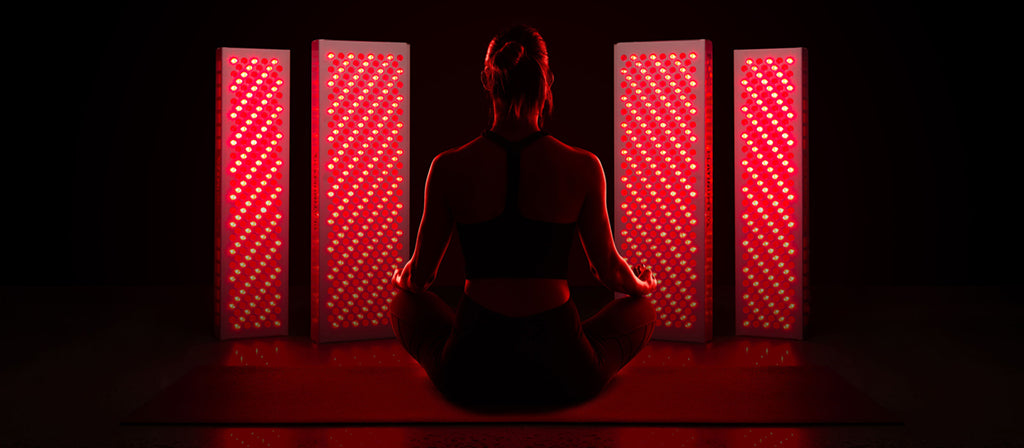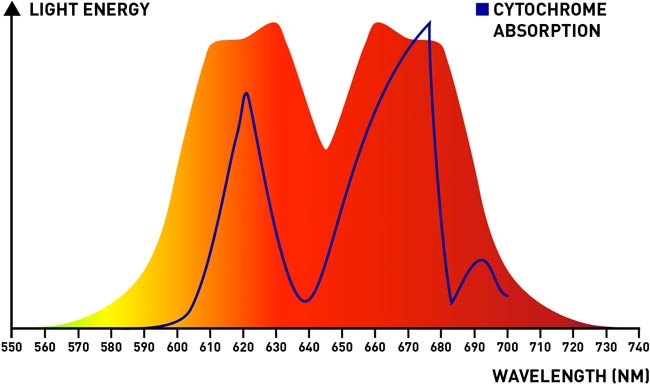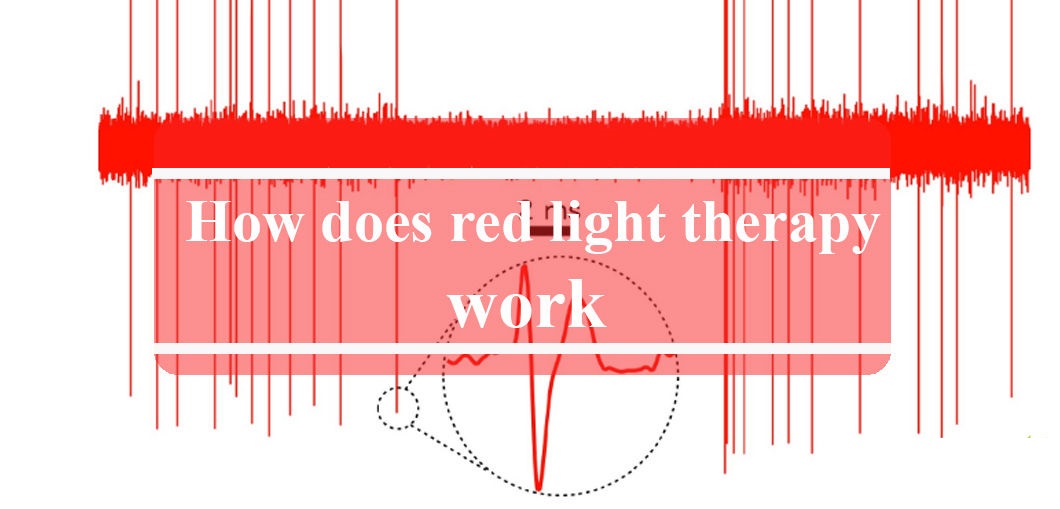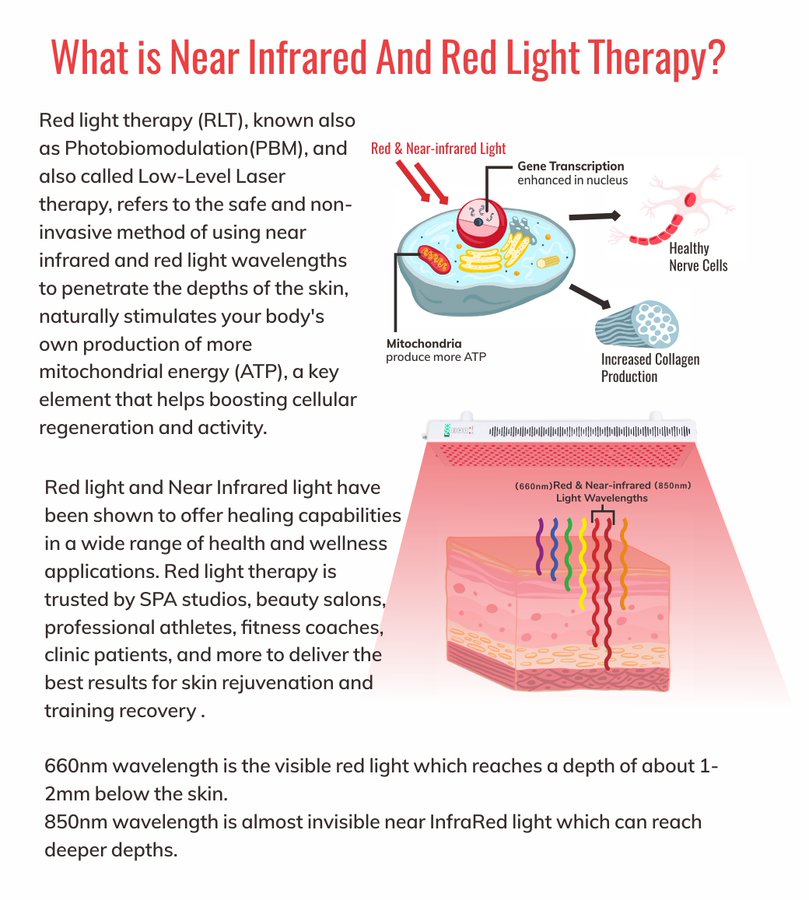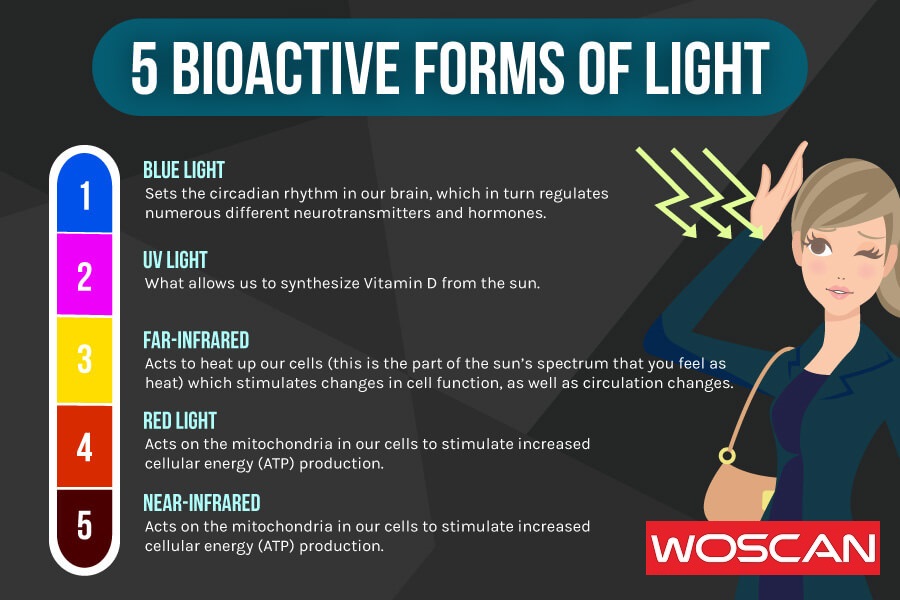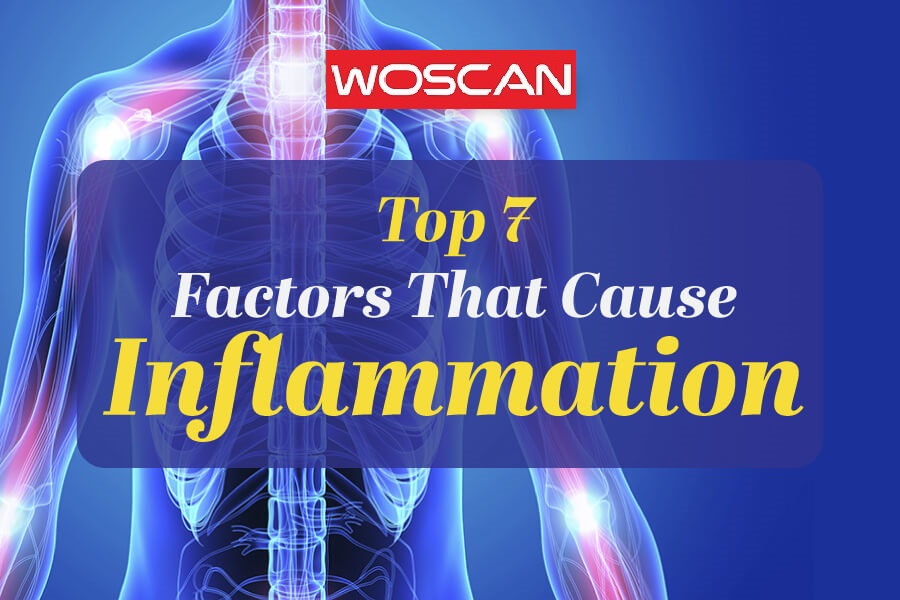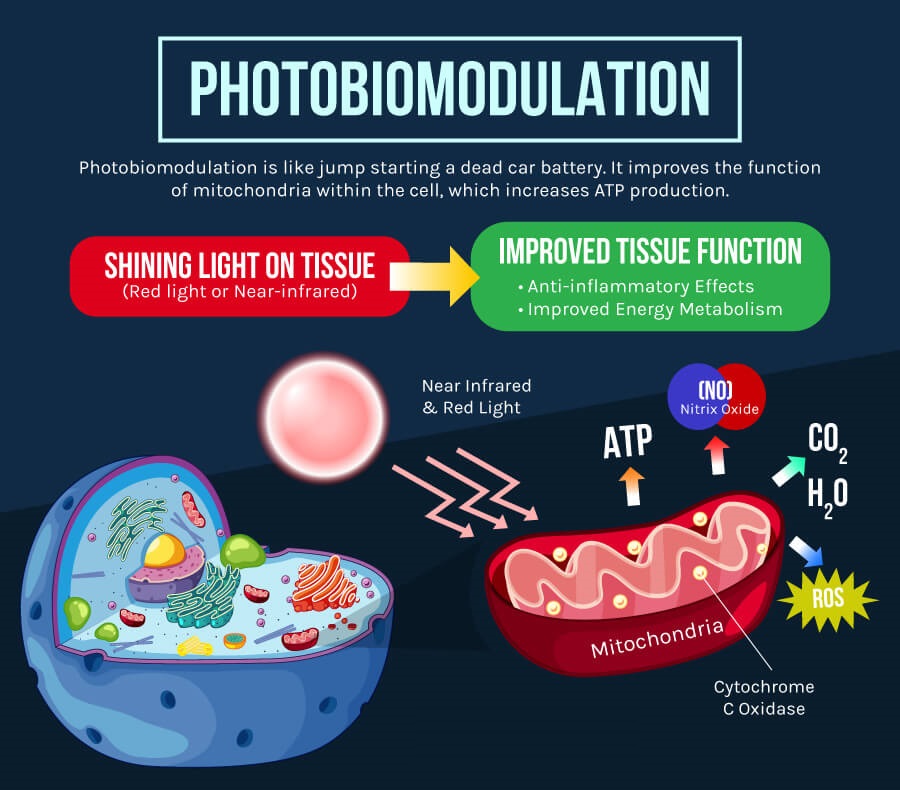
Welcome to Red Light Therapy (RLT)! While it might sound futuristic or even abstract to some, this therapy harnesses the power of specific wavelengths of light to potentially confer neuroprotective effects. But how does a mere light exert such profound biological effects, particularly in a disorder as intricate as Parkinson’s?
At its core, RLT operates on a principle called photobiomodulation. In this process, the light stimulates cytochrome c oxidase, a pivotal enzyme in our mitochondria responsible for the cellular production of adenosine triphosphate (ATP), the primary energy currency of our cells. By enhancing ATP production, cells are energized and can function more optimally, and in the context of PD, this can translate to alleviated symptoms and improved motor functions.
In this article, we’ll delve deep into the biological intricacies of RLT, explore its potential in addressing the multifaceted challenges posed by Parkinson’s Disease, and provide insights for those considering this therapy option. Whether you or a loved one is affected by PD, or you’re merely curious about the science behind this innovative approach, read on to discover the potential of Red Light Therapy.
What is Red Light Therapy?
Red Light Therapy (RLT) has piqued the interest of many within the medical and therapeutic communities, offering a non-invasive approach to various conditions. At its essence, RLT employs specific wavelengths of red and near-infrared (NIR) light to bring about a series of physiological changes within cells. But before diving into its mechanism, let’s trace back its origins and the foundational principles of this therapy.
The history of using light as a therapeutic tool dates back centuries, but the more refined approach of using specific wavelengths, like in RLT, began to gain traction in the late 20th century. Initially explored for its potential in wound healing and inflammation reduction, researchers soon recognized its broader applicability, including for neurological conditions such as Parkinson’s Disease.
From a technical standpoint, RLT predominantly uses wavelengths in the range of 600-1100 nm, a spectrum covering both red and near-infrared light. These specific wavelengths are chosen for their ability to penetrate skin and soft tissues, reaching cells and even deeper structures with precision. Not all light is created equal, and these wavelengths, in particular, have the capacity to bring about cellular change without causing damage, unlike ultraviolet (UV) rays.
So, how does shining a light result in biological effects? The principle of photobiomodulation. When cells, particularly their mitochondria, absorb these light wavelengths, there’s an elevation in the activity of cytochrome c oxidase. This enzyme plays a key role in the mitochondrial electron transport chain, effectively boosting the synthesis of adenosine triphosphate (ATP). Elevated ATP levels signify more cellular energy, rejuvenating cells, enhancing their function, and potentially repairing damage.
The Biological Mechanism of RLT in the context of PD
The intricacies of Parkinson’s Disease (PD) are still the subject of intensive research, but its impact on cellular functions is evident. A prominent theory surrounding its pathogenesis links the disease to mitochondrial dysfunction. This is where Red Light Therapy (RLT) emerges as a promising avenue, providing potential benefits at the very core of cellular operations.
- The Pivotal Role of Mitochondria in Cellular Energy Production: Mitochondria, are responsible for the generation of a vast majority of the energy needed for cellular processes. This energy is stored in the form of adenosine triphosphate (ATP). ATP acts as the primary energy currency, driving numerous cellular processes and ensuring cell health and functionality.
- RLT’s Influence on Mitochondria: At the heart of RLT’s physiological mechanism lies photobiomodulation. When cells are exposed to specific wavelengths of red and near-infrared light, a significant component that responds is the mitochondrial enzyme cytochrome c oxidase. By absorbing these light wavelengths, cytochrome c oxidase enhances the efficiency of the electron transport chain. This elevation in activity translates to a boost in ATP synthesis, leading to an increase in available cellular energy.
- The Implications for Parkinson’s Disease: Parkinson’s Disease is believed to be, in part, a result of compromised mitochondrial function. This dysfunction can lead to reduced ATP production, rendering neurons more vulnerable to damage and less efficient in transmitting signals. By increasing ATP synthesis through RLT, there’s potential to restore some of this lost energy balance. This is pivotal, especially in dopaminergic neurons, the primary neuronal type affected in PD, as an improved energy state can potentially support better neuronal function and survival.
- Beyond Energy – The Battle Against Oxidative Stress and Inflammation: Apart from direct energy modulation, RLT has shown promise in modulating oxidative stress, a prominent feature in PD pathogenesis. PD-affected cells often show elevated levels of reactive oxygen species (ROS), which can inflict damage to cellular structures. RLT has been proposed to enhance the activity of antioxidant enzymes, countering ROS and reducing cellular damage. Simultaneously, RLT may play a role in reducing inflammation, another significant player in PD progression.
The promise of RLT in the context of Parkinson’s Disease is anchored in its potential to rejuvenate cellular functions at their core, specifically within the mitochondria. By addressing both the energy imbalances and the heightened oxidative stress characteristic of PD, RLT offers a multifaceted approach that could complement existing therapeutic strategies. As research continues to delve into these mechanisms, the hope is to provide a more comprehensive understanding and, possibly, more effective interventions for those affected by PD.
Scientific Studies on RLT and Parkinson’s Disease
The realm of Red Light Therapy (RLT), particularly its application in neurological disorders such as Parkinson’s Disease (PD), is characterized by a growing body of scientific literature. These studies, some of which we’ll delve into below, provide a foundational understanding of how RLT could be beneficial for PD and reflect its emerging significance in this therapeutic arena.
“Treatment of Neurodegeneration: Integrating Photobiomodulation and Neurofeedback in Alzheimer’s Dementia and Parkinson’s: A Review”
This comprehensive review delves into the intersection of photobiomodulation, often referred to as PBM (an umbrella term encompassing RLT), and neurofeedback, particularly in the context of neurodegenerative diseases. A notable observation from this study is the tangible impact of PBM on cognitive function. The review specifically mentions:
“PBM-treated subjects showed that active treatment subjects tended to show greater improvement in the functioning of the executive: clock drawing, immediate recall, practical memory, and visual attention and task switching.” [1]
Such findings underscore the potential of RLT in not only addressing motor symptoms in PD but also cognitive facets that are often affected as the disease progresses.
“Photobiomodulation Therapy and Cell Therapy Improved Parkinson’s Diseases by Neuro-regeneration and Tremor Inhibition”
This study stands out due to its exploration of the dual therapeutic potential of both photobiomodulation and cell therapy for PD. The positive outcomes observed are concisely summarized in the study’s assertion:
“The results of the studies showed that cell therapy and laser therapy are useful in the therapy of PD, and despite their limitations, they can be useful in improving PD.”[2]
The combined potential of cell therapy and laser therapy (a form of RLT) demonstrates their synergistic promise for PD management.
“Improvements in clinical signs of Parkinson’s disease using photobiomodulation: a prospective proof-of-concept study”
This prospective study shines light on the direct clinical implications of PBM for PD patients. It rigorously evaluated PBM’s safety and efficacy profile, leading to a notable conclusion:
“PBM was shown to be a safe and potentially effective therapy for a range of clinical signs and symptoms of PD.”[3]
Safety is always paramount when exploring new therapeutic interventions, and the acknowledgment of PBM’s safety, coupled with its potential efficacy, further strengthens its case for inclusion in PD therapeutic strategies.
In summary, while the journey of scientific exploration and understanding is ongoing, the current trajectory of research underscores the potential of Red Light Therapy in improving various aspects of Parkinson’s Disease. The combination of safety profiles and observed therapeutic effects makes RLT an area of promise and keen interest in the world of PD research and management.
Who Can Benefit from RLT for Parkinson’s Disease?
The vast spectrum of Parkinson’s Disease (PD) symptoms and progression rates means that individuals affected by this condition have diverse therapeutic needs. As Red Light Therapy (RLT) gains traction in the realm of PD management, one might ask, “Who stands to gain the most from this modality?” Here, we’ll navigate this question by considering the physiological mechanisms and the segments of the PD population that might benefit from RLT.
- Early-stage PD Patients:
RLT’s foundation in photobiomodulation involves stimulating the mitochondrial enzyme cytochrome c oxidase. This enhances ATP synthesis, providing rejuvenated cellular energy and possibly aiding in cellular repair.
For those in the early stages of PD, when cellular dysfunction has commenced but not reached its zenith, RLT could potentially slow the progression. By supporting cellular health through boosted ATP production, early-stage patients might witness a delay in the onset of more pronounced symptoms. - PD Patients with Cognitive Challenges:
Some studies suggest that RLT can influence cognitive function, likely due to enhanced cellular function and reduced oxidative stress, both of which are critical for neuron health and function.
Patients manifesting cognitive disturbances or decline might experience improvements or stabilization in their cognitive state. This offers hope not just for motor symptom relief but also for the broader cognitive challenges PD can present. - Those Experiencing Mood Disturbances:
Beyond its impact on cell energy dynamics, RLT has shown potential in modulating oxidative stress and inflammation, both of which can influence neurotransmitter balance and, consequently, mood.
PD patients often grapple with mood disorders like depression and anxiety. RLT might offer a therapeutic avenue for mood stabilization by addressing underlying cellular and neurochemical imbalances. - Advanced PD Patients Seeking Complementary Therapies:
While the foundational mechanism remains consistent, the diverse effects of RLT, ranging from reduced inflammation to improved cellular function, can be complementary to existing therapeutic strategies.
Patients already on conventional therapies who seek additional or holistic approaches might find RLT beneficial. It can act as a supplementary modality, potentially enhancing the overall therapeutic outcome. - Individuals Keen on Non-pharmacological Options:
RLT’s non-invasive and non-pharmacological nature relies on the principles of light and cellular interaction to exert its effects.
For those wary of medication side-effects or those seeking non-drug alternatives, RLT presents an attractive option, offering benefits without the typical pharmacological side-effect profile.
In conclusion, while RLT holds promise for a broad segment of the PD community, its impact might vary based on individual disease progression, symptomatology, and overall health. As always, the decision to integrate RLT into a management plan should be made in consultation with healthcare professionals, ensuring that the therapy aligns with individual needs and therapeutic goals.
How to Choose a Quality RLT Device for Home Use
Incorporating Red Light Therapy (RLT) into your health regimen from the comfort of your home can be a powerful step towards addressing various concerns, including Parkinson’s Disease. However, with the market replete with myriad devices claiming therapeutic efficacy, making an informed choice becomes paramount. Here, we guide you through the essential considerations, backed by scientific understanding, to help you select a quality RLT device for home use.
WAVELENGTH SPECIFICITY:
RLT operates on the principle of photobiomodulation. It’s crucial to ensure the device emits light in the therapeutic range, typically 670 nm (red) and 810 (near-infrared). For a comprehensive list of wavelengths and health benefits, you may visit our Red Light Wavelengths page.
Check the device specifications to confirm the wavelengths offered. Both ranges have distinct penetrative capabilities and physiological effects, making them suitable for different applications
DEVICE POWER AND IRRADIANCE:
The therapeutic efficacy of RLT depends on delivering the correct dose of light energy to the targeted tissues. This is determined by the device’s power output and irradiance (energy delivered per unit of time over a specific area, measured in mW/cm^2).
A quality RLT device will specify its irradiance. Higher irradiance means shorter therapy sessions for the same energy dose. Aim for devices with irradiance levels that align with research-backed therapeutic doses. To make it easier to calculate session times, visit our Red Light Dosing Calculator.
TREATMENT AREA COVERAGE:
Effective photobiomodulation requires adequate light exposure to the desired treatment area. The size and design of the RLT device play roles in determining this coverage.
Depending on your therapeutic goals, select a device that provides optimal coverage. For targeted areas, handheld devices might suffice, while larger panels may be more suitable for whole-body exposure.
FDA-CLEARANCE:
An FDA-cleared device has undergone evaluation for safety and efficacy based on existing medical standards.
To ensure both safety and potential efficacy, opt for RLT devices that are FDA-cleared. This certification is a testament to the manufacturer’s compliance with established regulations.
CONSISTENCY AND UNIFORMITY OF LIGHT:
Uniform exposure ensures consistent photobiomodulation across the treatment area, maximizing therapeutic benefits.
Devices with closely spaced LEDs or optimized beam angles ensure a more uniform distribution of light, enhancing the therapy’s efficacy.
DEVICE DURABILITY AND WARRANTY:
Given that the therapeutic potential of RLT requires consistent use over time, the device’s longevity and reliability become crucial.
Opt for devices with robust construction and backed by a comprehensive warranty. Trusted manufacturers often offer extended warranty periods, indicating confidence in their product’s durability.
While the allure of RLT’s therapeutic promise is compelling, ensuring you choose a quality device is pivotal. As you navigate your options, keeping these scientific and technical considerations in mind will guide you toward a device that aligns with your therapeutic goals and provides the best value for your investment.
The exploration into Red Light Therapy (RLT) for Parkinson’s Disease offers a compelling glimpse into the promise of photobiomodulation in addressing complex neurodegenerative conditions. Grounded in the intricate dance of light with our body’s cellular machinery, particularly the stimulation of the mitochondrial enzyme cytochrome c oxidase, RLT showcases a union of nature’s simplicity with scientific innovation.
Our journey through understanding the biological underpinnings, scrutinizing the scientific evidence, assessing its comparative stance against conventional therapies, and gleaning practical insights for integration underscores one pivotal message: RLT is more than just a modality. It’s a testament to the ever-evolving narrative of healthcare, where non-invasive, scientifically backed therapies are reshaping patient experiences.
For those grappling with Parkinson’s Disease, and even for those without, RLT stands as a beacon of hope and potential. But like all therapies, its efficacy is tightly interwoven with its application. Armed with knowledge and the right tools, individuals stand on the threshold of possibly transforming their therapeutic outcomes.
As the scientific community delves deeper into RLT’s vast expanse, it beckons users to approach it with an open mind, grounded understanding, and an appreciation for the nuanced interplay of light with life. The future of RLT is luminous, and for many, it might just be the therapeutic beacon they’ve been seeking.
[1] Berman MH, Nichols TW. Treatment of Neurodegeneration: Integrating Photobiomodulation and Neurofeedback in Alzheimer’s Dementia and Parkinson’s: A Review. Photobiomodul Photomed Laser Surg. 2019 Oct;37(10):623-634. doi: 10.1089/photob.2019.4685. PMID: 31647776.
[2] Ahrabi B, Tabatabaei Mirakabad FS, Niknazar S, Payvandi AA, Ahmady Roozbahany N, Ahrabi M, Torkamani SD, Abbaszadeh HA. Photobiomodulation Therapy and Cell Therapy Improved Parkinson’s Diseases by Neuro-regeneration and Tremor Inhibition. J Lasers Med Sci. 2022 Jun 23;13:e28. doi: 10.34172/jlms.2022.28. PMID: 36743130; PMCID: PMC9841383.
[3] Liebert A, Bicknell B, Laakso EL, Heller G, Jalilitabaei P, Tilley S, Mitrofanis J, Kiat H. Improvements in clinical signs of Parkinson’s disease using photobiomodulation: a prospective proof-of-concept study. BMC Neurol. 2021 Jul 2;21(1):256. doi: 10.1186/s12883-021-02248-y. PMID: 34215216; PMCID: PMC8249215.



